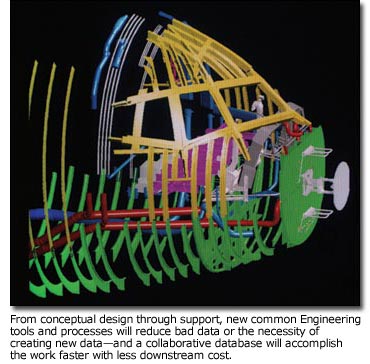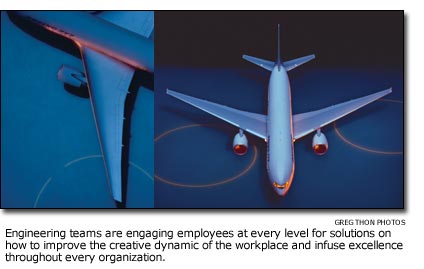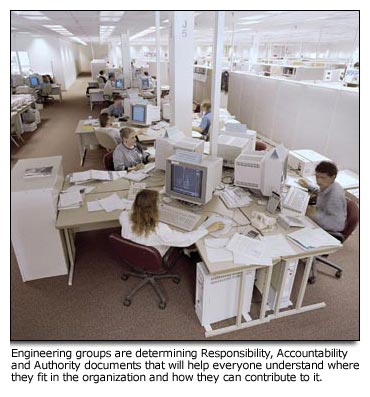| Ending the frustration
Engineering People Plan engages
employees to help bring order, add value to the workplace
BY RICK ROFF

 The engineering work environment at Commercial Airplanes didn't
get to where it is overnight.
The engineering work environment at Commercial Airplanes didn't
get to where it is overnight.
Try 50 years.
The company had conducted 13 studies since 1952 to understand better
how to match engineering employee skills and interests with work
that is meaningful and challenging.
When Engineering and Product Integrity Vice President Hank Queen
set out to address the concerns two years ago, he didn't need a
14th study.
"We had all the data we needed to start making changes," Queen
said. "Our engineers went on strike in 2000, and we learned a lot
from them. Our recent employee survey indicated continued frustration
and confusion of our people throughout the organization.
"It wasn't time for another study; it was time to get to work."
Although previous studies had pointed to frustrations in the workplace,
none ever brought about meaningful action. The reason is not surprising.
"This is a tough problem, probably one of the most difficult we
will ever solve," Queen said. "Fundamentally, it involves changing
our behavior and redefining our jobs, in management and non-management,
so that we're not wasting our time doing things that don't add value."
What has emerged to respond to the challenge is the Engineering
People Plan, which consists of 15 elements: utilization, organizational
alignment, workforce development, internal communications, training,
knowledge retention and transfer, technical excellence, virtual
teaming, coaching and mentoring, fair compensation, diversity, leadership
development, skill teams, process improvement and ethics (See
sidebar below).
Teams support each of the elements and engage employees at all
levels to listen and work together on making improvements. Teams
include union staff members from the Society of Professional Engineering
Employees in Aerospace who have been involved either as participants
or leaders on some of the plan's elements. The Ed Wells Initiative,
which promotes engineering excellence throughout Boeing, also plays
a pivotal role.
Engaging employees is the most critical component to the people
plan's success.
"At its core, engagement means that teams of people at the work-group
level must get together to decide what is important to them and
then take action," Queen said.
Managers have been asking the people who work for them three questions:
What is your current job satisfaction level? What is most important
to you about your job? What are the biggest issues or greatest barriers
to improving your organization?
Managers are accountable not only for business performance of their
organizations but also for how well they listen and work with their
teams to implement improvements and meet employees' needs. And they
are to report back to Queen semi-annually with results on the job
satisfaction question.
Utilization
One of the foundational People Plan elements is Utilization, which
the company defines as increased productivity and job satisfaction.
An organization accomplishes utilization by having the right people
doing the right work with the right processes and tools at the right
time.
Project manager Ken Kirwan said people have indicated through surveys
that they want meaningful and challenging work, opportunities for
advancement and achievement, and recognition and acknowledgement
for a job well done.
"Employees have told us that the company doesn't use its technical
talent efficiently, that they don't feel well-utilized and often
are performing tasks that don't take advantage of their education
or experience," Kirwan said.
He said there are several things managers can do to improve employee
utilization: "They can improve the balance between engineering and
technical employees. They can help the group improve quality of
output so time is not spent in rework. And they can provide growth
opportunities so employees continue to learn and develop new skills."
Another important element of utilization is to involve employees
in identifying issues and barriers that get in the way of improving
their performance.
 "By
asking employees in the work group what their biggest issues are,
and by engaging them in finding the solutions together, the team
can make significant gains in both productivity and job satsisfaction,"
Kirwan said. "They are tightly linked together." "By
asking employees in the work group what their biggest issues are,
and by engaging them in finding the solutions together, the team
can make significant gains in both productivity and job satsisfaction,"
Kirwan said. "They are tightly linked together."
To this end, the organization has asked every manager to develop
his or her own people plan based on feedback from the three questions
(What is your current job satisfaction level? What is most important
to you about your job? What are the biggest issues or greatest barriers
to improving your organization?).
"Our strategy for the future includes achieving competitive advantage
by leveraging the best talent, technology, processes and tools,"
Kirwan said. "In support of this goal, we're challenging ourselves
to improve our productivity by 100 percent. It's definitely doable,
with the commitment, engagement and support of the whole team."
Organizational alignment
Jill Heydron said that when people hear the words Organizational
Alignment, they immediately begin thinking there's an effort under
way to move people around on an organizational chart.
"It's the No. 1 question and misunderstanding I receive from folks
even today," said Heydron, project leader. "We should be calling
this Organizational Enlightenment. It's what we're really doing:
establishing and clarifying the organizational culture to bring
a clearer understanding for how the work groups are aligned."
Employees have complained about having too many managers and receiving
multiple work statements from different work groups. Reporting relationships
and "who does what" have not been clear.
A matrix of operating principles and boundary tables brings order
to the organization. The principles define distinct areas of responsibility
for skill and process leaders, and business unit leaders. Boundary
tables reach a lower level of definition, dealing with cross-model
work statements, budgets, retentions, merits, career plans and so
on.
"Managers in some cases are just now reviewing the operating principles
and boundary tables with their work groups and in some cases actually
are beginning to use them," Heydron said. "Some of what they're
learning is, 'OK, so if I'm in a business unit and have a work statement
that requires more people than I have to perform that work, I look
to my skill and process leader for help, because it isn't in my
role to move or acquire people for that work.'"
The last step of the project currently under way is creating Responsibility,
Accountability and Authority documents to help groups determine
what they're responsible for and whether they have authority and
accountability for that responsibility.
"Most of the groups that we have today don't even have an RAA,
so that has contributed to the confusion," Heydron said. "There
aren't group-level responsibilities so people can see how they fit
in the organization, and they don't exist at the higher levels,
either. RAA helps everyone find themselves in the organization and
understand how they can contribute."
Heydron estimates that the team is halfway through the project,
with engagement on RAAs the biggest piece of the puzzle.
"The first step is to explain the matrix so people can begin to
understand the principles and tables and how they apply to them,"
she said.
The response so far has been encouraging.
"We're hearing more and more that this is one of the better pieces
of documentation yet developed on understanding how the organization
works," Heydron said. "We've got a ways to go, but we're definitely
moving in the right direction."
Workforce development
Another issue that emerged from last year's employee survey was
job security, and the Workplace Development team began exploring
a solution.
 "It
occurred to us that one of the key things that could be done would
be to prepare employees for future roles that they would play in
the company," said Dean Tudor, SPEEA employee, co-director at the
Ed Wells Initiative and team co-leader with Mike Denton, vice president
of Engineering for Airplane Programs and Commercial Aviation Services.
"This was something we could do that was crucial to stabilizing
employment." "It
occurred to us that one of the key things that could be done would
be to prepare employees for future roles that they would play in
the company," said Dean Tudor, SPEEA employee, co-director at the
Ed Wells Initiative and team co-leader with Mike Denton, vice president
of Engineering for Airplane Programs and Commercial Aviation Services.
"This was something we could do that was crucial to stabilizing
employment."
He said the approach has been to help paint a picture of what the
future skills are going to be and to ensure that employees have
the training and education to meet those needs.
As a result of this new direction, workforce development took on
a different complexion, with a focus on the business role within
Engineering.
"We think our major early deliverable will be a picture of the
future," Tudor said. "We've asked skill leaders and process leaders
about the direction of the organization, what skills they think
they will need three to five years from now and the plans for getting
there."
The objective is to make the information available to everyone
as soon as possible.
"Employees need to know what direction their organization is going
so they can make choices about their development," Tudor said. "The
organizations that provide training need the information so they
know what to focus on.
"This is an exciting time for us, because to my knowledge there
has never been such a future-oriented approach," Tudor said.
Virtual teaming
As Commercial Airplanes employees continue to address the future
in building airplanes, there is a constant effort to reduce development
costs.
That's where Virtual Teaming comes in.
Frank Statkus, who leads the effort, said two aspects are instrumental
in shaving costs — the common use of tools and processes, and
a collaborative database.
"No matter what part of the development phase employees are working,
from conceptual design through support, common tools and processes
will reduce the existence of bad data or the necessity of creating
new data, and a collaborative database will accomplish the work
faster," Statkus said.
As Boeing partners with companies around the world to develop new
products such as the Sonic Cruiser, a collaborative database is
critical.
"The whole team will not only work on the same product, they also
will work on it in a common way," Statkus said. "Someone on the
outside will not be able to tell who is doing what part of the work,
because the whole team, no matter where they are in the world, will
be working to the same requirements with the same processes and
common tool sets."
Statkus, who was in charge of the Joint Strike Fighter effort for
Boeing, said it's not a brand-new approach for the company.
"We know from experience that there's huge value in doing it this
way — to product integrity and certainly to the cost of the
overall product," he said.
In the past, design data could come in different forms and reside
in separate databases, requiring translation of data that often
provided inaccurate and very expensive results.
For example, outside mold lines of an airplane might be in one
database and the rest of the design — locations of stringers,
spars and ribs — in a different database. During translation,
errors would accumulate in the database itself. Manipulation of
the data to make it work would lead to inaccuracy and create downstream
rework, delays, additional tooling and skyrocketing costs.
The technology is being transferred to Commercial Airplanes' Advanced
Development program, which is drawing employees from Commercial
Airplanes, Phantom Works and Integrated Defense Systems.
"The Sonic Cruiser is a first application for the technology, but
eventually it will become an enterprise-wide tool," Statkus said.
"That way we only have to do this once across the enterprise."
"These are real exciting times," he added. "These are the kind
of activities in this company that are going to make our future
extremely competitive."
richard.g.roff@boeing.com
|